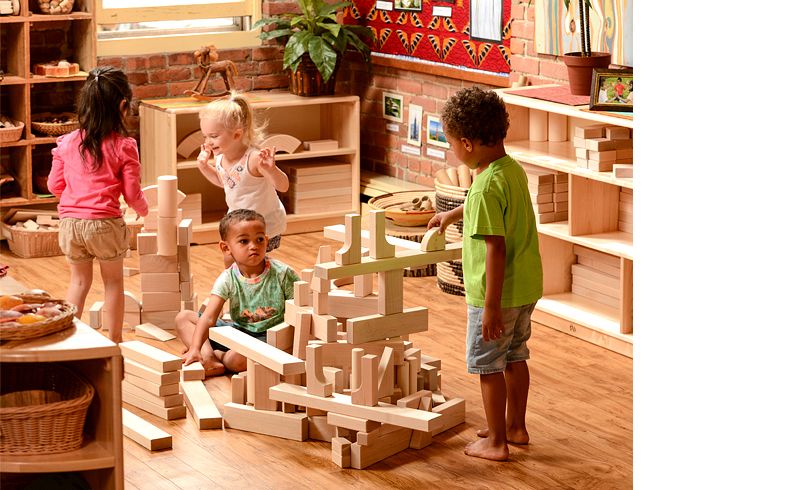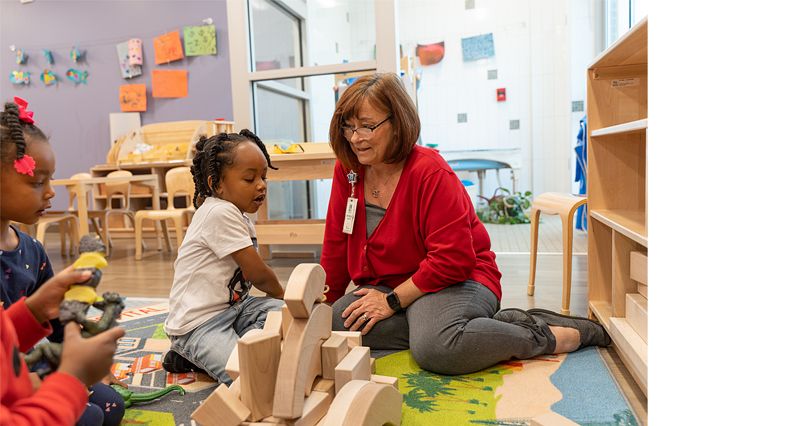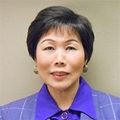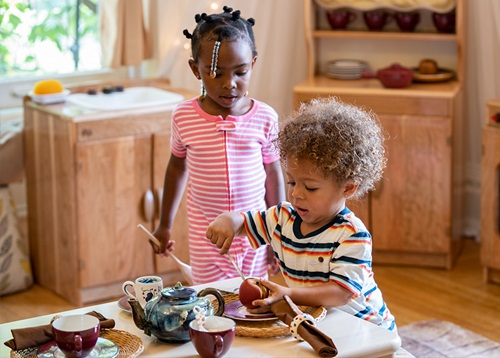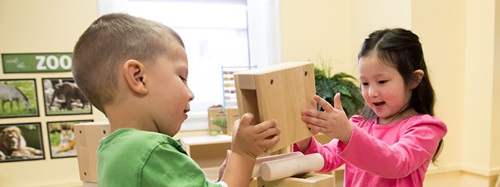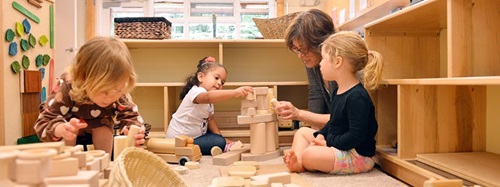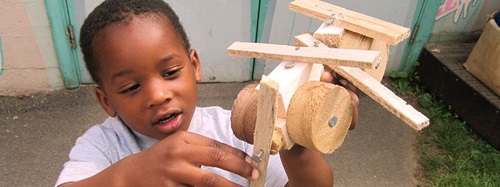Building 21st Century Skills Block by Block
The Importance of Block Play
|
July 2014
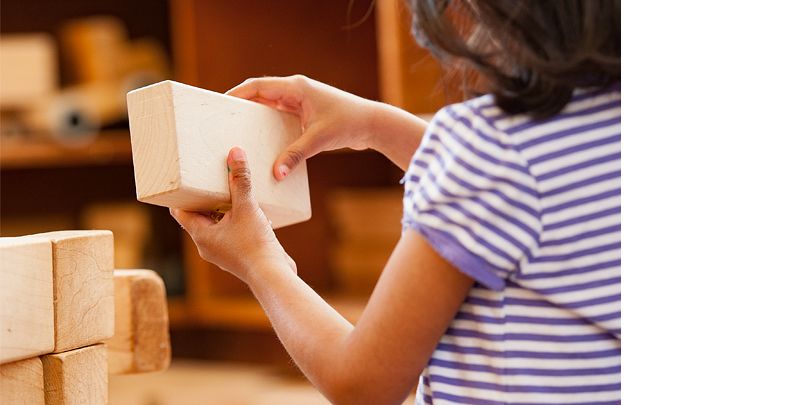
Blocks are universal play materials; they are found in preschool classrooms around the globe. Many researchers have documented the benefits of playing with blocks. However, despite evidence that play activities are the best way to develop and foster the skills children need to compete in the 21st century world, block play remains largely a “choice” activity limited by time and space.
Today’s children are facing an increasingly global stage filled with the opportunities and challenges of a rapidly changing world. The subsequent escalation of academic pressure on young children is a concern for many early childhood educators. Play is vanishing from classrooms as teachers try to align their curriculum to meet new state standards. It’s time to look again at block building as an essential learning process which fosters and facilitates the learning and innovative skills children need to be successful in the future.
Challenges in Block Play
Most early childhood educators can identify the benefits of block play, which include fostering the development of children’s mathematical, language, social, and spatial reasoning skills. However, on average, most classrooms schedule block play for only 30 minutes, and the number of children involved is limited by the physical space allotted.
Those children who do engage in block play often exhibit low levels of performance evidenced by stacking blocks together in simple structures. Few children contemplate complex designs like bridges or towers. Because of the relatively short play periods, children are not able to complete their block constructions, resulting in frustration. Although many early childhood experts recommend extended block play in order to help children develop these important skills, changes have been minimal.
An Alternative Approach on Block Building
In other cultures, however, there is greater emphasis on block building as an important pillar of education. During a study-abroad trip to Asia, I was surprised by the amazing block constructions I saw in the Kindergarten classrooms we visited. The rules for block play and complex building plans hung on the wall. Children were working together in large open spaces on different parts of intricate block constructions: partially or nearly completed cities, gardens, and amusement parks.
These centers view block play as an important daily routine. They extend block play to a much longer period of time (one week or longer) and use it as an important learning process. Children start with a planning process where they share their ideas about what they plan to build. This is followed by a visualization phase where the children diagram and draw their plans on paper. Teachers facilitate this process by joining individual ideas into a group plan. The children then outline the rules they need to follow during block building and these rules are written by the teacher on a chart. This whole process usually takes two half-hour sessions over two days.
Once the initial planning is complete, the children use their daily designated block play time (average 30-45 minutes per day) to carry out their plans. Alterations of the design are allowed if the child articulates a meaningful reason for a change: not enough blocks, lack of accessories, or simply, “it did not work.” The children’s work, whether finished or unfinished, remains undisturbed in a designated area with a sign saying, “Do Not Touch.”
Over the course of three or more consecutive days, the children work on their block constructions. After completion, there is a small celebration with an exhibition of their work to parents, teachers, and other children. Most teachers also hold a brief discussion session with the children to reflect on the process of their work. It is believed that intended planning can produce powerful learning outcomes.
Through the continuous block building progression, teachers are encouraged to guide the children’s thought processes and help them connect and expand their knowledge. Children have the opportunity to apply and practice their receptive and expressive language skills; develop and apply mathematical concepts; practice social skills such as taking turns, waiting, and sharing; and test their spatial reasoning skills. Furthermore, this structure of extended block play can eliminate the challenges teachers face during daily cleanup time.
Fostering 21st Century Learning and Innovative Skills
In their book, 21st Century Skills: Learning for Life in Our Time, Bernie Trilling and Charles Fadel describe the 21st century learning model and indicate that powerful learning follows a sequence of phases: define, plan, do, and review.
The children we observed on our study trip to Asia were provided with an opportunity to initiate, plan, and implement their ideas, and then share their accomplishments. The whole process is aligned with the 21st century learning model, as well as High-Scope’s plan-do-review learning process developed more than 40 years ago.
Trilling and Fadel also identify the most essential 21st century learning and innovation skills as: critical thinking and problem solving, creativity and innovation, and communication and collaboration. Do block building experiences foster and enhance these skills that children need for future success?
Fostering Critical Thinking & Problem Solving Skills
Critical thinking and problem solving go hand on hand. Ellen Galinsky, in her book Mind in the Making, identifies critical thinking as one of the seven essential life skills needed by every child. Children exhibit these skills at an early age.
Block building requires children to engage in more complex thinking processes than general block play. In the block building process, teachers challenge children with higher-level thinking such as: what happens if you add these pieces on the top of that tower? why? As a follow up, teachers can ask children about alternative ways to solve these problems.
Enhancing Creativity and Innovation Abilities
Although the term “creativity” is often associated with people’s artistic talents, all individuals—adults and children alike—have creative potential. What is the difference between creativity and innovation? According to Paul Sloane, creativity is the ability to conceive unusual and original ideas, while innovation is the ability to implement these new ideas.
Most people think of children as being creative, yet in most situations their creative ideas remain very basic due to a lack of experience or cognitive processing. Although many teachers provide opportunities for children to express their creative thoughts, there are few situations for children to implement their creative ideas and assess their success.
During block building, children are able to express their creative ideas through the different designs that they would like to build. Teachers can foster creative thought processes by utilizing story books and pictures. Similarly, open-ended questions such as: “is there another way you could. . .” or, “will you be able to use different things to. . .” can challenge children to think creatively. Children can also be encouraged to use their imagination and use an object to represent a play accessory (such as use a block to pretend as a phone) during block building.
During the construction period, children can implement their ideas to determine what works. If some design fails, teachers can challenge children to find alternative solutions. In this way, block building provides the opportunity for children to develop creative ideas and use their innovative abilities in the design and construction of a complex structure.
Supporting Communication & Collaboration Development
Preschool is the prime time to develop children’s language and literacy skills. Block building facilitates this development when children use their language skills to explain their thought process and share their ideas with others. Effective communication is necessary in the block corner to resolve social problems and tensions that inevitably arise. Teachers should provide children with the appropriate vocabulary to express their feelings and articulate their desires.
Many people would characterize children as egocentric or having difficulty collaborating with others. Although not completely false, this characterization fails to understand that collaborative skills can be learned from a very young age. Teachers can strategically place two or three children together and provide them with a simple task to work together on.
The Teachers’ Role
Teachers play an import role in scaffolding children’s cognitive knowledge and fostering 21st century skills during block building. To make this activity a rewarding learning experience, teachers need to:
- Identify a large, open indoor or outdoor space (foyer, back the classroom, end of the hall way, court yard, etc…) that can keep children’s block constructions for longer periods of time.
- Modify class routines and curriculum to integrate block building as a core learning activity.
- Observe children in the block building area with intent and provide support as needed.
- Utilize scaffolding strategies to connect cognitive knowledge with block building experiences.
- Ask higher-level, open-ended questions to foster children’s critical thinking and problem solving skills.
- Encourage and create collaborative engagement opportunities for children to work together.
- Help children solve social problems by using effective communication skills or offer alternative strategies.
- Offer support and reward children’s learning by providing positive comments and encouragement.
The benefits of block building are clearly documented. It is time to call for action and rethink how we structure block play in our daily curriculum. By utilizing the 21st century learning process in block play, early childhood educators could deepen children’s cognitive understanding, enhance children’s social skills, and equip children with the life skills they need to succeed.
References:
High-Scope. (2014). Approach to Learning, Retrieved from http://www.highscope.org/Content.asp?ContentId=719
Galinsky, E. (2010) Mind in the Making, HarperCollins
Partnership for 21st Century Skills (P21). (2008). 21st Century Skills, Education & Competitiveness: A Resource and Policy Guide. Retrieved from http://www.p21.org/storage/documents/21st_century_skills_education_and_competitiveness_guide.pdf
Sloane, P. (2012). What’s the Difference Between Creativity and Innovation? Retrieved from www.innovationexcellence.com/blog/2012/08/04/whats-the-difference-between-creativity-and-innovation/
Trilling, B & Fadel, C. (2009). 21st Century Skills: Learning for Life in our Time, Jossey-Bass.

